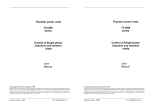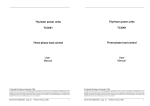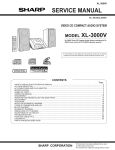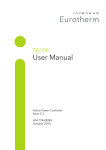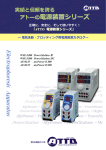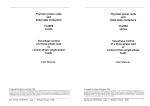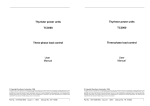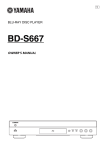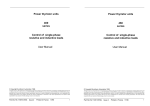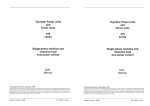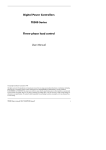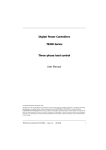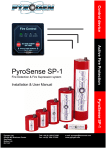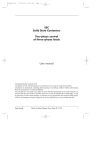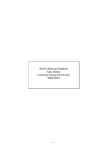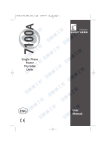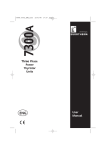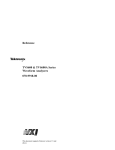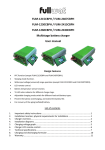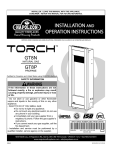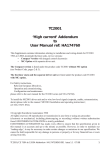Download TC1028 series Thyristor units Control of single
Transcript
TC1028 series Thyristor units Control of single-phase resistive or inductive loads User manual (300A to 500A rated units) ©Copyright Eurotherm Automation 1998 All rights reserved. All reproduction or transmission in any form or using any procedure (electronic or mechanical, including photocopying or recording) without written authorisation from EUROTHERM AUTOMATION is strictly prohibited. EUROTHERM AUTOMATION has made every effort to ensure that the specification given in this manual is as accurate and up to the minute as possible. However, in order to maintain our ‘leading edge’, it may be necessary to make certain changes or omissions to our specification. We cannot be held responsible for any damage to persons or property or for any financial loss or costs arising from this. TC1028 User Manual Ref. HA174804ENG Issue 2.0 09/98 i IDENTIFYING THE THYRISTOR UNITS TC1028 USER MANUAL SCOPE OF MANUAL This TC1028 User Manual (Ref: HA 174804 ENG) is intended for 300A to 500A rated units in the TC1028 series carrying the CE mark, manufactured from December 1995. The TC1028 Manual (Ref: HA 172963) is valid for units manufactured before this date. The TC1028 Addendum (Ref: HA 174804 ENG 001) is intended for 750A to 1200A rated units. CONTENTS EUROPEAN DIRECTIVES . . . . . . . . . . . . . . . . . . . . . . . . . .iv CE MARKING AND SAFETY . . . . . . . . . . . . . . . . . . . . . . . . .iv ELECTROMAGNETIC COMPATIBILITY (EMC) . . . . . . . . .iv PRECAUTIONS . . . . . . . . . . . . . . . . . . . . . . . . . . . . . . . . . . . . .v CHAPTER 1 IDENTIFYING THE THYRISTOR UNITS . . . . . . . . . . . .1-1 GENERAL INTRODUCTION TO THE TC1028 SERIES . . .1-2 TECHNICAL SPECIFICATION . . . . . . . . . . . . . . . . . . . . . . .1-7 PRODUCT CODE FOR TC1028 SERIES . . . . . . . . . . . . . . .1-10 EXAMPLE OF PRODUCT CODE . . . . . . . . . . . . . . . . . . . .1-11 SERIAL NUMBER LABELS . . . . . . . . . . . . . . . . . . . . . . . .1-12 CHAPTER 2 INSTALLATION . . . . . . . . . . . . . . . . . . . . . . . . . . . . . . . . . .2-1 INSTALLATION - SAFETY . . . . . . . . . . . . . . . . . . . . . . . . . .2-2 DIMENSIONAL DETAILS . . . . . . . . . . . . . . . . . . . . . . . . . . .2-3 MECHANICAL MOUNTING . . . . . . . . . . . . . . . . . . . . . . . . .2-5 INSTALLATION DETAILS . . . . . . . . . . . . . . . . . . . . . . . . . . .2-6 CHAPTER 3 WIRING . . . . . . . . . . . . . . . . . . . . . . . . . . . . . . . . . . . . . . . . .3-1 WIRING - SAFETY . . . . . . . . . . . . . . . . . . . . . . . . . . . . . . . . .3-2 CONNECTING THE POWER CABLES . . . . . . . . . . . . . . . .3-3 REFERENCE VOLTAGE CONNECTION . . . . . . . . . . . . . . .3-6 CONTROL CABLES . . . . . . . . . . . . . . . . . . . . . . . . . . . . . . . .3-7 CONTROL TERMINAL BLOCK . . . . . . . . . . . . . . . . . . . . . .3-9 INPUT SIGNALS . . . . . . . . . . . . . . . . . . . . . . . . . . . . . . . . . .3-11 SINGLE-PHASE LOAD WIRING DIAGRAM . . . . . . . . . .3-19 THREE-PHASE LOAD WIRING DIAGRAMS . . . . . . . . . .3-20 PLF ALARM . . . . . . . . . . . . . . . . . . . . . . . . . . . . . . . . . . . . .3-24 ii TC1028 User manual IDENTIFYING THE THYRISTOR UNITS CHAPTER 4 CONFIGURATION . . . . . . . . . . . . . . . . . . . . . . . . . . . . . . . .4-1 CONFIGURATION - SAFETY . . . . . . . . . . . . . . . . . . . . . . . .4-2 POWER BOARD . . . . . . . . . . . . . . . . . . . . . . . . . . . . . . . . . . .4-3 DRIVER BOARD . . . . . . . . . . . . . . . . . . . . . . . . . . . . . . . . . . .4-4 CHAPTER 5 OPERATION . . . . . . . . . . . . . . . . . . . . . . . . . . . . . . . . . . . . . .5-1 THYRISTOR FIRING MODES . . . . . . . . . . . . . . . . . . . . . . . .5-2 CONTROL OPERATION . . . . . . . . . . . . . . . . . . . . . . . . . . . . .5-7 CURRENT LIMIT . . . . . . . . . . . . . . . . . . . . . . . . . . . . . . . . .5-10 PARTIAL LOAD FAILURE DETECTION . . . . . . . . . . . . . .5-12 RETRANSMISSION . . . . . . . . . . . . . . . . . . . . . . . . . . . . . . .5-13 ENABLE / INHIBIT . . . . . . . . . . . . . . . . . . . . . . . . . . . . . . . .5-14 ‘MASTER / SLAVE’ OPERATION . . . . . . . . . . . . . . . . . . . .5-14 CHAPTER 6 COMMISSIONING PROCEDURE . . . . . . . . . . . . . . . . . . .6-1 COMMISSIONING PROCEDURE - SAFETY . . . . . . . . . . . .6-2 CHECKING THE CHARACTERISTICS . . . . . . . . . . . . . . . .6-3 DIAGNOSTIC UNIT . . . . . . . . . . . . . . . . . . . . . . . . . . . . . . . .6-5 PRELIMINARY ADJUSTMENTS . . . . . . . . . . . . . . . . . . . . .6-8 PARTIAL LOAD FAILURE DETECTION ADJUSTMENT 6-12 CURRENT LIMIT ADJUSTMENT . . . . . . . . . . . . . . . . . . . .6-13 TROUBLESHOOTING . . . . . . . . . . . . . . . . . . . . . . . . . . . . .6-15 CHAPTER 7 MAINTENANCE . . . . . . . . . . . . . . . . . . . . . . . . . . . . . . . . . .7-1 THYRISTOR PROTECTION . . . . . . . . . . . . . . . . . . . . . . . . .7-2 THYRISTOR PROTECTION FUSE . . . . . . . . . . . . . . . . . . . .7-3 FUSE-BLOWN INDICATION MICROSWITCH . . . . . . . . . .7-4 PROTECTION FUSES FOR REFERENCE VOLTAGE CONNECTION . . . . . . . . . . . . . . . . . . . . . . . . . . . . . . . . . . . .7-5 SERVICING . . . . . . . . . . . . . . . . . . . . . . . . . . . . . . . . . . . . . . .7-6 TOOLS . . . . . . . . . . . . . . . . . . . . . . . . . . . . . . . . . . . . . . . . . . .7-7 TC1028 User manual iii IDENTIFYING THE THYRISTOR UNITS RELEVANT EUROPEAN DIRECTIVES CE MARKING AND SAFETY TC1028 products carry the CE mark in compliance with the essential requirements of the European Low Voltage Directive 73/23/EEC, amended by the Directive 93/68/EEC. Declaration of CE conformity For safety reasons, Eurotherm certifies that TC1028 products, installed and used in compliance with this User Manual, meet the essential requirements of the European Low Voltage Directive mentioned above. A declaration of CE conformity is available on request. Validation by Competent Body Eurotherm has validated the compliance of TC1028 products with the European Low Voltage Directive and with the EMC test standards listed below through product design and laboratory testing. These are described in a Technical Construction File, validated by a Recognised Competent Body: the LCIE (Central Laboratory for the Electrical Industries). ELECTROMAGNETIC COMPATIBILITY (EMC) The electromagnetic compatibility of TC1028 products has been designed specially for an industrial environment; they must not be used in domestic environments. Statement of EMC conformity Eurotherm certifies that TC1028 products, installed and used in compliance with this User Manual, meet the following EMC test standards and enable the system which incorporates them to comply with the EMC Directive, as far as the TC1028 products are concerned. EMC tests Immunity Emission iv EMC test standards Electrostatic discharge EN 61000-4-2 (06/1995) Fast transients (bursts) EN 61000-4-4 (01/1995) RF electomagnetic fields prEN 61000-4-3 (1984) Radiated EN 55011 (1991) EN50081-2 Class A Conducted EN 55011 (1991) IEC 1800-3 for 2nd environment TC1028 User manual IDENTIFYING THE THYRISTOR UNITS PRECAUTIONS Safety symbols Important safety precautions and special information are indicated in the text of the manual by two symbols: DANGER ! WARNING This symbol means that failure to take note of the information given in this manual may have serious consequences for the safety of personnel and may even result in electrocution. This symbol means that failure to take note of the information may • have serious consequences for the installation or • lead to the incorrect operation of the unit. These symbols must be observed for particular points. However the whole of the manual remains applicable. Personnel The installation, configuration, commissioning and maintenance of the unit must only be carried out by personnel qualified and trained to work with low voltage electrical equipment in an industrial environment. EMC Guide In order to help you reduce the effects of electromagnetic interference depending on the product installation, Eurotherm can supply you with the 'Electromagnetic Compatibility' Installation Guide (Ref: HA 025464). This guide lists the rules generally applicable for EMC. Independent alarm Given the safety regulations concerning personnel and property, and the value of the equipment controlled by TC1028 products, we recommend the use of an independent safety device (alarm), which must be tested regularly. Eurotherm can supply various types of alarm systems for this purpose. Further information For any further information, or if in doubt, please contact Eurotherm Controls where qualified staff are available to advise or assist you with the commissioning of your installation. TC1028 User manual v IDENTIFYING THE THYRISTOR UNITS Chapter 1 IDENTIFYING THE THYRISTOR UNITS Contents Page GENERAL INTRODUCTION TO THE TC1028 SERIES . . .1-2 TECHNICAL SPECIFICATION . . . . . . . . . . . . . . . . . . . . . . .1-7 PRODUCT CODE . . . . . . . . . . . . . . . . . . . . . . . . . . . . . . . . .1-10 EXAMPLE OF PRODUCT CODE . . . . . . . . . . . . . . . . . . . .1-11 SERIAL NUMBER LABELS . . . . . . . . . . . . . . . . . . . . . . . .1-12 TC1028 User manual 1-1 IDENTIFYING THE THYRISTOR UNITS Chapter 1 IDENTIFYING THE THYRISTOR UNITS GENERAL INTRODUCTION TO THE TC1028 SERIES The TC1028 series of thyristor units are designed for the control of industrial single-phase loads. The TC1028 series is designed to control: • inductive loads (transformer primaries in particular) or • resistive loads with a large temperature coefficient. A thyristor unit comprises a pair of thyristors connected in anti-parallel and mounted on a heat sink, together with control and alarm circuits. The TC1028 series of thyristor units control currents up to 1650A. This User Manual is valid for TC1028 units rated between 300A and 500A. The nominal line-to-line voltage is between 100V and 690V (depending on the product code). The control signal, which can be reconfigured by the user, has four voltage levels: 0-5V; 0-10V; 1-5V; 2-10V, and two current levels: 0-20mA; 4-20mA. Manual control using an external potentiometer is possible. The TC1028 series is equipped with the following functions: • electrical power control of inductive and resistive loads • various thyristor firing modes • current reduction by soft starting for loads with large temperature coefficient • elimination of overcurrent when starting inductive loads • current limit • partial load failure detection • logic output to control other power units (‘Slave firing’ output) • selective pulse blocking circuit • inhibit input available on user terminal block • retransmission of load current and voltage • bargraph current level display on front panel. 1-2 TC1028 User manual IDENTIFYING THE THYRISTOR UNITS Upper protection cover Bargraph 100 50 0 “PLF detection” indicator light Load Fail Déf. Charge Adjust Seuil PLF adjustment Current limit potentiometer Test I limit Limit. I Delay Retard “PLF test” pushbutton Delayed firing or starting ramp potentiometer Access door to diagnostic connections ε EUROTHERM Control cable clamp Lower protective cover PLF contact terminal block Cable gland for load cables Reference voltage terminal black Figure 1-1 Overview of TC1028 series thyristor unit (500V version) TC1028 User manual 1-3 IDENTIFYING THE THYRISTOR UNITS The standard (basic) version of the TC1028 series of controllers is fitted with: • a thyristor firing board (‘power board’) which generates thyristor firing pulses and provides current and voltage measurement • a ‘driver board’ which produces signals to control thyristor firing • a ‘potentiometer board’ to allow adjustment of delayed firing (inductive loads), and soft start time • a ‘filter board’ to protect thyristor unit operation from transient interference. As an option, the TC1028 may be fitted with a board which plugs into the driver board and which converts the instantaneous current into an rms current measurement (‘RMS option board’). The RMS value of the load current is displayed on a bargraph and is retransmitted via a signal available on the user terminal block. The control system uses analogue feedback of load voltage squared (V2) or load current squared (I2), the highest value being automatically selected. TC1028 units compensate for supply variations in the range +10% to -15% of the nominal voltage. TC1028 series thyristor units are used for control of electrical loads such as: • loads with large resistance variations as a function of temperature • transformer primaries • inductors. The following features are found on the front panel: • potentiometer to adjust the initial firing delay on inductive loads, or soft start duration • diagnostics connector • bargraph showing the mean or RMS current (optional) • potentiometer for partial load failure detection adjustment • ‘Test’ pushbutton to test the PLF alarm adjustment • 1-4 indicator light to display PLF detection. TC1028 User manual IDENTIFYING THE THYRISTOR UNITS Power supply connection screw Safety earth Filter LINE Internal thyristor protection fuse Power board Load connection Flat connection cable Fan LOAD PLF contact terminal block Filter board Ground bonding link Reference voltage Control terminal block Potentiometer board Driver board RMS option board Figure 1-2 Circuit boards for the TC1028 series thyristor unit (500V version) TC1028 User manual 1-5 IDENTIFYING THE THYRISTOR UNITS TC1028 thyristors have the following thyristor firing modes: • ‘Phase angle’ - variation in the thyristor firing angle • ‘Burst-firing’ - modulation of burst-firing duty cycle from 0 to 100% ‘Burst mode’ firing is characterised by various modes: • ‘Single-cycle’ one cycle of firing or non-firing • ‘slow cycle’ burst-firing (modulation time 8s at 50% setpoint) • ‘fast cycle’ burst-firing (modulation time 0.8s at 50% setpoint) • burst-firing (fast or slow cycle) with phase angle soft start • burst-firing (fast or slow cycle) with phase angle soft start and end The soft start for large temperature coefficient resistive loads and the delayed firing angle in the first half-cycle when controlling inductive loads, minimise transient overcurrents. (Which otherwise can cause fuse blowing or trigger a protective circuit breaker.) The soft start and end time can be adjusted between 0 and 0.25s via the potentiometer on the front panel. TC1028 units have two types of current limit: • linear limit (adjusted by potentiometer on front panel) • threshold limit (adjusted by external potentiometer) The partial load failure detection circuit (PLF) detects 25% increases in load impedance (independent of supply voltage variations). PLF detection is adjusted by a potentiometer on the front panel, which is used to set the actual load current. PLF alarm signalling is provided by the alarm relay contacts and by the ‘Load Fail’ indicator light on the front panel. Thermal protection is provided by means of a thermal switch which senses fan failure or heatsink over-temperature. TC1028 units have active “enable”. An external 10V signal (32V max.) or a switch connected to the user terminal block are used to enable operation. Absence of the enable voltage or opening of the switch contacts causes inhibition of the controller. 1-6 TC1028 User manual IDENTIFYING THE THYRISTOR UNITS TECHNICAL SPECIFICATION (units rated between 300A and 500A) The TC1028 is a power thyristor unit designed to control an inductive industrial load or a load with a high current requirement at start-up. Warning! ! It is the user’s responsibility to ensure, before commissioning the controller, that all the nominal ratings of the controller are compatible with the conditions of use and the installation. Power Nominal current Nominal line-to-line voltage Supply frequency Dissipated power Fan Load 300A, 400A, 500A 100Vac to 690Vac (+10%, -15%) Inhibition below 80% of nominal voltage; response time <10ms; automatic reset 2s after return to nominal 50Hz or 60Hz (±2Hz) 1.3W per amp. (Allow 2W per amp to include fuse) 6.5W consumption, (24Vdc fan) Self-supplied by power circuit for 300A to 500A rated units External supply for other ratings (see addendum HA17804ENG001) Resistive with large temperature coefficient or inductive (transformer primary or inductor) Environment Operating temperature Storage temperature Protection Thyristor protection Wiring Atmosphere Humidity Pollution Altitude Dimensions (Up to 500V) (690V) TC1028 User manual 0°C to +50°C in vertical position (+40°C for 500A nominal; at +50°C, derate to 450A) -10°C to +70°C Two covers provide IP20 protection on the front panel Internal high-speed fuse, with ‘fuse-blown’ indication microswitch option, MOV (varistor) and RC snubber To be carried out in compliance with Standard IEC 364 Non-explosive, non-corrosive & non-conductive RH: 5% to 95%, non-condensing Pollution degree 2 permissible, defined by IEC 664 2000m maximum 570mm (H) x 133mm (W) x 268mm (D) Weight 10kg 570mm (H) x 248mm (W) x 268mm (D) Weight 19kg 1-7 IDENTIFYING THE THYRISTOR UNITS Control Power supply Input type Range Input impedance Manual control Thyristor firing modes The following may be reconfigured by the user: • Phase angle • Single-cycle (Burst-firing with one firing or non-firing cycle) • Fast cycle burst-firing (typical modulation time at 50% power : 0.8s) • Slow cycle burst-firing (typical modulation time at 50% power : 8s) • Fast cycle with adjustable soft start between 0 and 250ms (with or without soft end) • Slow-cycle with adjustable soft start between 0 and 250ms (with or without soft end) Delayed thyristor firing For inductive loads, delayed firing in the first half-cycle of burst-firing (without soft start) eliminates transient overcurrents Enable / Inhibit Diagnostics Control type Wiring Connections 1-8 Self-supplied from power circuit (300A to 500A rated units) with reference phase (or neutral) connection Consumption: 20VA Analogue Voltage : 0-5V; 1-5V; 0-10V or 2-10V Current : 0-20mA; 4-20mA Voltage : ≥50kΩ Current : 250Ω 5kΩ external potentiometer Using external contacts or external voltage (10VDC) to enable Response time : enable, 2s; inhibit < 25ms Connector for diagnostic unit permits adjustment and test of thyristor unit. Control of load voltage squared or load current squared Supply variation compensation Shielded cable connected to ground at both ends 0.52mm to 1.02mm conductors Tightening torque 0.7Nm TC1028 User manual IDENTIFYING THE THYRISTOR UNITS RMS option board Retransmissions Display Current limit Linear limit Threshold limit RMS load current DC signal (0-10V) proportional to the actual load current. Retransmission output on the user terminal block Display of RMS current using 10-segment bargraph Proportional load current limit (from 20 to 100% of the nominal current) Adjustment using potentiometer on front panel Maximum load current limit Adjustment using external potentiometer Partial load failure detection Alarm Detection of 20% decrease in current Adjustment by potentiometer marked ‘Adjust’ on front panel Test Using ‘Test’ push button on front panel Signalling ‘Load fail’ indicator light on front panel Alarm relay contacts open in alarm state (in standard version) Alarm relay contacts closed in alarm state (IPF option) Bargraph Display • Instantaneous current (filtered mean value) for the adjustment of initial firing of thyristors in the case of inductive loads (basic version) • RMS value of load current in ‘Phase angle’ and ‘Fast cycle’ firing modes with or without soft start or end (with RMS option board) Warning! ! In order to maintain its 'leading edge', Eurotherm may have to make changes to its specifications without advance notice.For any further information, or if in doubt, please contact Eurotherm Controls. TC1028 User manual 1-9 IDENTIFYING THE THYRISTOR UNITS PRODUCT CODE FOR TC1028 SERIES TC1028 Nominal Nominal current voltage Fan supply Nominal current 300 amps 400 amps 500 amps 750 amps * 900 amps * 1200 amps * 1650 amps * Code 300A 400A 500A 750A 900A 1200A 1650A Nominal voltage 100 volts 110 volts 115 volts 120 volts 200 volts 220 volts 230 volts 240 volts 277 volts 380 volts 400 volts 415 volts 440 volts 480 volts 500 volts 690 volts Code 100V 110V 115V 120V 200V 220V 230V 240V 277V 380V 400V 415V 440V 480V 500V 690V Fan supply Self-supplied (300A to 500A rated units) External voltage * (ratings ≥ 750A) : 115 volts 230 volts Code Input signal 0-5 V 1-5 V 0-10 V 2-10 V 0-20 mA 4-20 mA Input signal Firing Manual Options 96 mode Input signal 0-5 V 1-5 V 0-10 V 2-10 V 0-20 mA 4-20 mA 00 Code 0V5 1V5 0V10 2V10 0mA20 4mA20 Thyristor firing mode Code Phase angle PA Single-cycle SGL ‘Fast cycle’ burst-firing (0.8s) FC ‘Fast cycle’ burst-firing with soft start SFC ‘Fast cycle’ burst-firing with soft start & end SDF ‘Slow cycle’ burst-firing (8s) SC ‘Slow cycle’ burst-firing with soft start SSC ‘Slow cycle’ burst-firing with soft start & end SDS Manual language English French German Italian Dutch Swedish Code ENG FRA GER ITA NED SWE 000 115V 230V Code 0V5 1V5 0V10 2V10 0mA20 4mA20 Options Code RMS current retransmission and display RMS 60Hz frequency 60H PLF alarm contacts closed in alarm state IPF Fuse-blown indicator microswitch FUMS No internal fuse NOFUSE Separate MC control unit * for ≥ 750A rated units; not available for 690V MC * See addendum HA174804ENG001 1-10 TC1028 User manual IDENTIFYING THE THYRISTOR UNITS Example of product code TC1028 controller and installation parameters Nominal load current Nominal supply voltage Analogue input signal Firing mode Options 250 amps 440 volts line-to-line 0 to 10 volts ‘Fast cycle’ burst-firing with soft start RMS current display and retransmission ‘Partial load failure’ detection alarm relay contacts closed in alarm state Fuse-blown indication microswitch Controller code: TC1028 / 300A / 440V / 000 / 0V10 / SFC / ENG / RMS / IPF / FUMS / 96 / 00 Warning! ! The nominal voltage of the TC1028 controller must correspond to the supply voltage used in order to eliminate problems of the controller not operating below 80% of the nominal voltage TC1028 User manual 1-11 IDENTIFYING THE THYRISTOR UNITS SERIAL NUMBER LABELS Two identification labels (which include the controller product code) and one configuration label provide all the information relating to the factory settings of the controller. One identification label is located externally on the right hand side of the unit. EUROTHERM 2.20 WORTHING, ENGLAND : 1903 268500 MODEL : TC1028/300A/440V/000/0V10/SFC/RMS/ENG/IPF/FUMS/96/00 SERIAL No. : LC1111/001/001/11/97 RATING : 1 PHASE 300A 440V 50Hz AUXILIARY POWER SUPPLY : SELF-SUPPLIED MADE IN FRANCE Figure 1-3 Example of identification label for a TC1028 controller The information corresponds to the product code example The second identification label and the configuration label are located inside the controller. SERIAL No : LC1111/001/001/11/97 TC1028 FACTORY SETTINGS : INPUT FIRING OPTION(S) : : : 0-10V DC FAST CYCLE BURST MODE FUSE-BLOWN INDICATION SWITCH CONTACTS CLOSED IN ALARM STATE RMS BOARD ANY NON-SPECIFIED FUSE INVALIDATES GUARANTEE (SEE USER MANUAL HA174804ENG) Figure 1-4 Example of configuration label for a TC1028 controller Warning! ! 1-12 Following any re-configuration on the part of the user, there is no guarantee that the controller will correspond to the label information. TC1028 User manual INSTALLATION Chapter 2 INSTALLATION Contents Page INSTALLATION - SAFETY . . . . . . . . . . . . . . . . . . . . . . . . . .2-2 DIMENSIONAL DETAILS . . . . . . . . . . . . . . . . . . . . . . . . . . .2-3 MECHANICAL MOUNTING . . . . . . . . . . . . . . . . . . . . . . . . .2-5 INSTALLATION DETAILS . . . . . . . . . . . . . . . . . . . . . . . . . . .2-6 TC1028 User manual 2-1 INSTALLATION Chapter 2 INSTALLATION INSTALLATION - SAFETY Danger! TC1028 units must be installed by personnel trained to work with low voltage electrical equipment in an industrial environment. Units must be installed in fan-cooled electrical cabinets, to ensure that condensation and pollution are excluded. The cabinet must be closed and bonded to the safety earth in accordance with IEC 364 or current national Standards. For installations which are fan-cooled, it is recommended that a fan-failure detection device or a thermal safety cut-out should be fitted in the cabinet. The TC1028 series of units may be bulkhead mounted. The units must be mounted with the heatsink positioned vertically, with no obstructions above or below which could inhibit or impede airflow. If several units are mounted in the same cabinet, they must be arranged in such a way that air expelled from one cannot be drawn into the unit located above it. Warning! ! The units are designed to be used at an ambient temperature less than or equal to 50°C (40°C for 500A nominal units). Leave a minimum gap of 5cm between two units placed side by side. Excessive overheating may lead to incorrect operation of the unit. This may in turn cause damage to the components. TC1028 series power units have permanent fan cooling. 2-2 TC1028 User manual INSTALLATION DIMENSIONAL DETAILS Dimensions and weights of TC1028 controllers (units rated between 300A and 500A) are given • in Figure 2-1 • and in Table 2-1 Door fixing Upper protection cover V R 100 50 0 Load Fail Déf. Charge Adjust Seuil Test I limit Limit. I Delay Retard B A ε EUROTHERM 110° Lower protection cover C U D Door open G Figure 2-1 Overall dimensions with upper protective cover TC1028 User manual 2-3 INSTALLATION Dimensions Values Description A 425mm Height without protective cover B 570mm Height with cover C 133mm Width (up to 500V) 248mm Width (690V) D 268mm Depth E 88mm Width between fixing holes (up to 500V) 203mm Width between fixing holes (690V) F 328mm Height between fixing holes G 557mm Depth with door open K 350mm Height of side faces R 20mm Distance between ‘Earth’ busbar and panel U 150mm Depth between ‘LOAD’ terminal and panel V 170mm Depth between ‘LINE’ terminal and panel 10kg Up to 500V 19kg 690V Weight Table 2-1 Dimensions and weights of TC1028 units (300A to 500A) 2-4 TC1028 User manual INSTALLATION MECHANICAL MOUNTING TC1028 controllers have two protective covers (upper and lower). The controllers may be mounted with their protective covers in position. However, the upper protective cover must be removed to make electrical connections. Having drilled the support panel to the dimensional values given above, insert the fixing screws halfway into the bulkhead / mounting plate holes. Offer up the controller by first engaging the heads of the upper screws in the respective holes on the upper section. Lower the unit making sure that it engages properly on the lower screws. Then slide the unit down completely until it is in position. Tighten the four screws correctly. TC1028 User manual 2-5 INSTALLATION INSTALLATION DETAILS TC1028 series units are designed to be mounted directly on to a panel using the fixing points located on the rear of the units. Protection cover Ø 9 13 Ø18 4 drilling holes for M8 screws K F Ø 9 10 E C Figure 2-2 Mounting details (300A to 500A rated units) 2-6 TC1028 User manual WIRING Chapter 3 WIRING Contents Page WIRING - SAFETY . . . . . . . . . . . . . . . . . . . . . . . . . . . . . . . . .3-2 CONNECTING THE POWER CABLES . . . . . . . . . . . . . . . .3-3 REFERENCE VOLTAGE CONNECTION . . . . . . . . . . . . . . .3-6 CONTROL CABLES . . . . . . . . . . . . . . . . . . . . . . . . . . . . . . . .3-7 MOUNTING . . . . . . . . . . . . . . . . . . . . . . . . . . . . . . . . . . .3-7 CONNECTION OF THE SHIELD TO THE GROUND .3-8 CONTROL TERMINAL BLOCK . . . . . . . . . . . . . . . . . . . . . .3-9 INPUT SIGNALS . . . . . . . . . . . . . . . . . . . . . . . . . . . . . . . . . .3-11 EXTERNAL ANALOGUE INPUT . . . . . . . . . . . . . . . .3-12 CONTROL OF MULTIPLE UNITS . . . . . . . . . . . . . . . .3-13 Wiring in parallel . . . . . . . . . . . . . . . . . . . . . . . . . . . . . . .3-13 Wiring in series . . . . . . . . . . . . . . . . . . . . . . . . . . . . . . . .3-14 MANUAL CONTROL WIRING . . . . . . . . . . . . . . . . . .3-15 EXTERNAL CURRENT LIMIT WIRING . . . . . . . . . . .3-16 RETRANSMISSION SIGNAL WIRING . . . . . . . . . . . . . . .3-18 SINGLE-PHASE LOAD WIRING DIAGRAM . . . . . . . . . .3-19 THREE-PHASE LOAD WIRING DIAGRAMS . . . . . . . . . .3-20 LOAD IN STAR WITH NEUTRAL . . . . . . . . . . . . . . . .3-21 LOAD IN OPEN DELTA . . . . . . . . . . . . . . . . . . . . . . . .3-22 LOAD IN STAR WITHOUT NEUTRAL OR IN CLOSED DELTA (TWO PHASE CONTROL) . . . . . . .3-23 PLF ALARM . . . . . . . . . . . . . . . . . . . . . . . . . . . . . . . . . . . . .3-24 TC1028 User manual 3-1 WIRING Chapter 3 WIRING WIRING- SAFETY Danger! Wiring must only be carried out by personnel who are qualified to work in a low voltage industrial environment. It is the user’s responsibility to wire and protect the installation in accordance with current professional Standards. A suitable device ensuring electrical isolation between the equipment and the supply must be installed upstream of the unit in order to permit safe maintenance. TC1028 series units have two protective covers : upper and lower. In order to make wiring easier, the upper cover should be removed. After connection and before powering up, replace the upper protective cover to ensure the specified degree of protection. Danger! • Before any connection or disconnection, ensure that power and control cables or leads are isolated from voltage sources. • For safety reasons, the safety earth cable must be connected before any other connection is made during wiring and it must be the last cable to be disconnected. The safety earth is connected to the screw located on the strip provided for this purpose in the upper part of the unit, behind the phase terminal and labelled: Danger! • To ensure correct grounding of the TC1028 unit, make sure that it is properly mounted on the reference ground surface (panel or bulkhead). Failing this, it is necessary to add a ground connection at most 10cms long between the earth connection and the reference ground surface. • This connection, which is intended to ensure good ground continuity, can never be used to replace the safety earth connection. 3-2 TC1028 User manual WIRING CONNECTING THE POWER CABLES The supply power cable passes through an opening in the upper protective cover of the TC1028 unit. In order to make connection of this cable easier, the upper cover of the unit is removed. To remove the cover: • open the access door by undoing the front screw located on the top left hand side of the door • lift the door in order to release it from its slots • open the door completely by pulling it towards you • remove the upper cover by unscrewing the two fixing nuts (by sliding it 1cm forwards to release the two catches located at the rear), and then raising it. The supply connection is made on the fuse stud on the upper part of the unit labelled LINE (see Figure 3-1). The load power cable passes inside the unit through a cable gland located below the unit. The aperture of this cable gland is up to 38mm. The load connection is made on the screw located on the lower part of the unit, labelled LOAD (see Figure 3-1). The power terminal capacities are given in Table 3-1. Tightening torques should not exceed the limits given in this table. Terminal Wiring details Supply and load Earth cable 185 to 2 x 150mm2 95 to 185mm2 Fuse stud Tightening torque M10 25Nm Load screw Tightening torque M12 43.5Nm Earth screw Tightening torque M12 43.5Nm Table 3-1 Power connection details (300A to 500A) The cross-section of the conductors to be used must comply with Standard IEC943. TC1028 User manual 3-3 WIRING Safety earth connection Thyristor protection fuse LINE Supply phase connection LOAD Load connection Figure 3-1 Fixing points for power cables (300A to 500A unit) 3-4 TC1028 User manual WIRING Distance between: Dimensions ‘Earth’ busbar and upper fixing hole 30mm ‘Earth’ busbar and left fixing hole 96mm ‘LOAD’ terminal and lower fixing hole 70mm ‘LOAD’ terminal and left fixing hole 20mm ‘LINE’ terminal and upper fixing hole 20mm Table 3-2 Details of power cabling ! Warning! The power cables leading to a load pass through a cable gland (aperture to 38mm), which must be tightened carefully after wiring. TC1028 User manual 3-5 WIRING REFERENCE VOLTAGE CONNECTION The reference voltage (second phase or neutral) used by the electronics is connected to a plug-in user terminal block, located on the right hand side below the unit. The maximum cross-section of the conductors is 1.5 mm2; tightening torque of control terminals : 0.7Nm. To second phase or neutral depending on wiring of load PLF Control cable clamp AA AA N/L2 Fusible 1A 71 Not used View of unit from below Reference voltage connection ternminal block Figure 3-2 Reference voltage connection terminal block The reference voltage (second phase or neutral) must correspond to the load configuration voltage. A 1A external fuse must be fitted to protect the reference voltage wiring. 3-6 TC1028 User manual WIRING CONTROL CABLES Warning! ! Control connections should be made using shielded cables grounded at both ends in order to ensure satisfactory immunity against interference. Separate the control cables from the power cables in the cable trays. Mounting The control wires must be grouped together in a shielded cable passing through the cable clamp located below the unit. Control cable clamp Tightening screw Lower cover Stirrup View of unit from below Figure 3-3 Location of control cable clamp Important! ! To facilitate earthing of the cable shield and to ensure maximum immunity from electromagnetic interference, the metal cable clamp is bonded directly to the ground of the unit. TC1028 User manual 3-7 WIRING Connection of the shield to the ground To insert the control cable and earth its shield: • Strip the shielded cable as shown in Figure 3-4a The control wires must be long enough for connection to be made to the user terminal blocks on the boards, whilst the bare screen is grounded at the metal cable clamp, when the door is open. Wiring inside the unit should be as short as possible. Control wires AAA AAA AAA AAA AAA Shield Insulating sheath 1·5 to 2 cm a) 20 to 40 cm Control wires Insulating sheath Shield folded back b) Figure 3-4 Control cable stripping • Fold back the shield on to the insulating sheath (Figure 3-4b) • Insert the cable into the metal cable clamp so that the shield is located in the stirrup and not inside the unit (at least, not beyond the lower cover). • Tighten the stirrup (4x1 flat-bladed screwdriver; tightening torque 0.7Nm) Lower cover AAAA A AAA AAAA AAAAAAAA AAAA AAA AA AAAA AAAA Wires Tighening screw Cable clamp Shield folded back Cable View from left side Figure 3-5 Cable tightening and shield grounding The possible diameter of the cables with the shield folded back is from 5mm to 10mm per cable clamp. 3-8 TC1028 User manual WIRING CONTROL TERMINAL BLOCK The following connections are made on the driver board user terminal block: • • • • • input signal (external or manual) “enable” for controller operation threshold current limit load current and voltage retransmission logic signal output to drive a solid state relay in ‘Master-Slave’ operation Access to the user terminal block is by opening the front door. Danger! 5 4 3 I LIMIT INPUT LOAD I OUTPUT LOAD V OUTPUT 1 6 MANUAL INPUT 2 7 AUTO INPUT 0V 8 SLAVE OUTPUT +10V 9 ENABLE Live parts may be exposed when the door is open if the TC1028 controller is powered up. Driver board Figure 3-6 Labelling of TC1028 control terminals Control terminal block terminal capacity 0.22mm2 to 1.5mm2. Control terminal tightening torque : 0.7Nm The input is isolated from the power supply and from the load circuit. TC1028 User manual 3-9 WIRING Terminal Labelling Function 1 0V Common 0V 2 +10V +10V user voltage 3 LOAD V OUTPUT Output for load voltage measurement retransmission 4 LOAD I OUTPUT Output for load current measurement retransmission 5 I LIMIT INPUT Input for threshold current limit 6 MANUAL INPUT Input for manual control signal 7 AUTO INPUT Input for automatic control signal 8 SLAVE FIRING OUTPUT Logic output to drive other units in ‘Master-Slave’ operation 9 ENABLE INPUT Enables thyristor operation Table 3-3 Terminal designation of TC1028 thyristor unit control terminal block 3-10 TC1028 User manual WIRING INPUT SIGNALS The control wires are connected on the plug-in user terminal block located on the driver board. The user terminal block can be accessed with the front door open. To open the door undo the front screw, release the door from its notches by lifting it up, then pull it towards you. Danger! Live parts may be exposed when the door is open if the controller is powered up. The units may be controlled by an external analogue signal (from a temperature controller or another signal source) or manually by an external potentiometer. TC1028 User manual 3-11 WIRING External analogue input The TC1028 may be configured for voltage input or current input signals. Signal type Voltage Signal level Input impedance 0 - 5V 50kΩ 1 - 5V 0 - 10V 2 - 10V Current 0 - 20mA 4 - 20mA 250Ω Table 3-4 TC1028 Input signals The external signal is applied to terminals 1 & 7 of the control terminal block (‘+’ on terminal 7). + Contacts N/C: Controller enable Control signal 9 8 7 6 5 4 3 2 1 ENABLE SLAVE OUTPUT AUTO INPUT MANUAL INPUT I LIMIT INPUT LOAD I OUTPUT LOAD V OUTPUT +10V 0V (Contacts open: inhibited) Driver board Figure 3-7 Wiring of external control signal For normal operation of the TC1028 series controller, also connect: • ‘Enable’ input (terminal 9) to the ‘+10V user’ voltage (terminal 2) • ‘Current limit’ input (terminal 5) to the ‘+10V user’ voltage • ‘Manual control’ input (terminal 6) to terminal 1 ‘0V’. 3-12 TC1028 User manual WIRING Control of multiple units The inputs of several controllers may be wired in parallel or in series. For this type of wiring all the thyristor units must have the same mode of firing and the inputs must be configured for the same signal type. Wiring in parallel The inputs must be configured as voltage inputs The input impedance per controller is 50kΩ The current required for each controller is 0.2mA at full scale. Control signal 0-5 V, 1-5 V, 0-10 V, 2-10 V Contacts N/C: Controller enable + 3 1 4 LOAD V OUTPUT 2 5 LOAD I OUTPUT 0V 6 I LIMIT INPUT +10V 7 MANUAL INPUT 8 SLAVE CONTROL Driver board 2 AUTO INPUT 9 ENABLE 3 1 4 LOAD V OUTPUT 2 5 LOAD I OUTPUT 0V 6 I LIMIT INPUT +10V 7 MANUAL INPUT 8 AUTO INPUT 9 3 LOAD V OUTPUT SLAVE CONTROL 4 LOAD I OUTPUT ENABLE 5 I LIMIT INPUT 1 6 MANUAL INPUT 2 7 AUTO INPUT 0V 8 SLAVE CONTROL Driver board 1 +10V 9 ENABLE (Contacts open: inhibited) Driver board 3 Figure 3-8 Parallel input wiring TC1028 User manual 3-13 WIRING Wiring in series The inputs must be configured as current inputs. Wiring in series is possible if all the controllers are configured for the same current signal (0 to 20mA, for example). For 0 to 20mA and 4 to 20mA inputs, the impedance of an input is 250Ω. For each input, 5 volts are required (for a current of 20mA). + Control signal 0 - 20 mA, 4 - 20 mA 2 1 3 0V 4 LOAD V OUTPUT +10V 5 LOAD I OUTPUT 7 AUTO INPUT 6 8 SLAVE CONTROL I LIMIT INPUT 9 ENABLE Driver board 2 MANUAL INPUT 1 3 2 4 LOAD V OUTPUT 0V 5 LOAD I OUTPUT +10V 6 7 I LIMIT INPUT 8 AUTO INPUT (Contacts open : inhibited) MANUAL INPUT 9 3 LOAD V OUTPUT SLAVE CONTROL 4 LOAD I OUTPUT ENABLE 5 I LIMIT INPUT 1 6 MANUAL INPUT 2 7 AUTO INPUT 0V 8 SLAVE CONTROL Driver board 1 +10V 9 ENABLE Contacts N/C: Controller enable Driver board 3 Figure 3-9 Series input wiring 3-14 TC1028 User manual WIRING Manual control wiring The TC1028 can be controlled by an external potentiometer (manual control). A 4.7kΩ to 10kΩ potentiometer should be connected between terminals 1 (‘0V’) and 2 (‘+10V’). The wiper is connected to terminal 6 (‘Manual input’). To use manual control, the controller input should be configured to 0 - 10V (see Product code). 4·7 to 10kΩ potentiometer 100% 0% Contacts N/C: Controller enable 2 1 0V 3 +10V 4 LOAD V OUTPUT 6 MANUAL INPUT 5 7 AUTO INPUT LOAD I OUTPUT 8 SLAVE CONTROL I LIMIT INPUT 9 ENABLE (Contacts open : inhibited) Driver board Figure 3-10 Wiring of manual input for TC1028 When manual control is used, terminal 7 of the external input labelled ‘Automatic input’ must be connected to ‘0V’ (terminal 1). Warning! ! If the input signal is not disconnected from terminal 7, the two signals (external and manual) are added together. TC1028 User manual 3-15 WIRING External current limit wiring TC1028 series thyristor units have two types of current limit (see Chapter 5 ‘Operation’): • linear limit (internal limit) and • threshold limit (external limit). External current limit is controlled by a voltage level or by an external potentiometer, and may be used with automatic external control as well as with manual control. External current limit may be adjusted in three different ways. 1. Adjustment by external voltage To implement threshold limit, a 0 - 10V external voltage should be connected between terminals 5 (‘I Limit’) and 1 (‘0V’), terminal 5 is positive. External current limit voltage (0 to 10V) + Contacts N/C: Controller enable 5 4 3 I LIMIT INPUT LOAD I OUTPUT LOAD V OUTPUT 1 6 MANUAL INPUT 2 7 AUTO INPUT 0V 8 SLAVE CONTROL +10V 9 ENABLE (Contacts open : inhibited) Driver board Figure 3-11 Wiring of external voltage for threshold current limit 3-16 TC1028 User manual WIRING 2. Adjustment by potentiometer For threshold current limit, it is possible to use an external potentiometer. A 4.7kW to 10kW potentiometer is connected between terminals 1 (‘0V’) and 2 (‘+10V’), its wiper is connected to terminal 5 (‘I Limit’). 4·7kΩ to 10kΩ potentiometer 100% current 0% current Contacts N/C: Controller enable 5 4 3 I LIMIT INPUT LOAD I OUTPUT LOAD V OUTPUT 1 6 MANUAL INPUT 2 7 AUTO INPUT 0V 8 SLAVE CONTROL +10V 9 ENABLE (Contacts open : inhibited) Driver board Figure 3-12 Wiring of external potentiometer for threshold current limit 3. Fixed external limit A fixed current limit of 110% of the nominal controller current is provided by connecting the ‘I Limit’ (terminal 5) to ‘+10V’ (terminal 2). ! Warning! If the external current limit is not used, terminals 5 and 2 must be connected. TC1028 User manual 3-17 WIRING Retransmission signal wiring Load current and voltage measurements are available on the control terminal block. The voltage measurement is retransmitted as a full-wave rectified signal proportional to the instantaneous value of the load voltage. The value of this signal is 5V rms (4.3V mean) for the nominal voltage. The voltage measurement is available between terminals 3 (‘Load V output’) and 1 (‘0V’). Retransmission of the current measurement requires the RMS board option. • In the basic version (without RMS option) the signal available between terminals 4 (‘Load I output’) and 1 (‘0V’) is a full-wave rectified signal proportional to the instantaneous value of the load current. The value of the retransmitted signal is 5V RMS (4.3V mean) for the nominal current of the power controller. • With the rms option, the signal retransmitted between terminals 4 and 1 of the driver board is proportional to the true rms value of the load current. The value of this signal is 10V for the nominal current of the controller. + Current measurement Voltage measurement + Contacts N/C: Controller enable 5 4 3 I LIMIT INPUT LOAD I OUTPUT LOAD V OUTPUT 1 6 MANUAL INPUT 2 7 AUTO INPUT 0V 8 SLAVE CONTROL +10V 9 ENABLE (Contacts open : inhibited) Driver board Figure 3-13 Wiring for retransmission signals The current measurement signal (with or without the RMS option) is displayed by the bargraph on the front panel of the controller. This bargraph has 10 segments, each segment represents 10% of the nominal current of the thyristor unit. 3-18 TC1028 User manual WIRING SINGLE-PHASE LOAD WIRING DIAGRAM Below is the wiring diagram for the power, safety earth and reference voltage for the control of a single-phase load in the TC1028 series of controllers. L1 Neutral or L2 Wire protection and mains circuit breaker (installed by users) Safety earth Internal fuse for thyristor protection LINE TC1028 1 A Fuse Power board LOAD PLF relay contact output 7 51 52 Control signal 1 71 Load Figure 3-14 Wiring of a TC1028 controller with a single-phase load TC1028 User manual 3-19 WIRING THREE-PHASE LOAD WIRING DIAGRAMS Although TC1028 series controllers are single-phase units, they may be used in combination to control three-phase loads. In three-phase use, the power and reference voltage wiring is determined by the load configuration. The most economical three-phase application is to use the TC1028 controller as the ‘Master’ with TC1027 series solid state relays acting as ‘Slaves’. The ‘Slave’ logic signal output is provided on the TC1028 control terminal block. The TC1027 solid state relay inputs must be configured for a 10V logic signal and connected in parallel. Important! ! 3-20 In ‘Master-Slave’ three-phase operation, only ‘burst-firing’ modes (Single-cycle, fast cycle and slow cycle) without soft operation are possible. TC1028 User manual WIRING Load type - star with neutral Wire protection and mains circuit breaker (installed by user) L1 L2 L3 N LINE 1 A Fuse TC1028 Power board 8 LINE LINE TC1027 TC1027 LOAD LOAD LOAD 7 11 13 11 13 1 71 + ‘Master-slave’ connection Control signal LOAD Figure 3-15 Wiring of a TC1028 controller (‘Master’) and two TC1027 solid state relays (‘Slaves’) for ‘star with neutral’ load configuration (for low temperature coefficient resistive loads only) TC1028 User manual 3-21 WIRING Load type - open delta For open delta load configuration (6-wire configuration), three TC1028 power controllers can be used with all the available firing modes. The power wiring given in the diagram below should be followed. Danger! The controllers and reference voltage circuits are at line-to-line voltage. Wire protection and mains circuit breaker (installed by user) Ph.1 Ph.2 Ph.3 LINE LINE TC1028 Power board LOAD 7 Control signal LINE TC1028 TC1028 Power board Power board LOAD 1 7 71 LOAD 1 7 1 71 71 + Three phase load in ‘open delta’ configuration Figure 3-16 Wiring diagram of three TC1028 controllers in ‘open delta’ (do not use for three phase transformer primaries) 3-22 TC1028 User manual WIRING Load type - star without neutral or in closed delta (two-phase control) For three-phase loads connected in star without neutral, or in closed delta (3-wire configuration) it is advisable to use two-phase control. One supply phase is direct (not controlled). In the two controlled phases a TC1028 controller, which operates as a ‘Master’, and a TC1027 operating as a ‘Slave’ must be connected together. The ‘Slave’ control logic output (terminal 8) is provided on the TC1028 driver board user terminal block. Wire protection and mains circuit breaker ( installed by user) L1 L2 L3 LINE LINE TC1027 TC1028 Power board LOAD 8 7 LOAD 1 11 13 71 + Control signal Three phase load in ‘star without neutral’ or ‘closed delta’ Figure 3-17 Wiring of a controller and a solid state relay in two-phase control (do not use for three phase transformer primaries) TC1028 User manual 3-23 WIRING PLF ALARM The partial load failure (PLF) detection alarm relay contacts, which signal the active state of the alarm, are connected to the user terminal block located below the unit on the left hand side. PLF The contact output terminals are 51 & 52. PLF alarm contact terminal block 51 N/L2 52 71 View of unit from below Figure 3-18 PLF alarm relay contact connection The PLF alarm relay is de-energised in the alarm state and in the absence of the power supply voltage. In the standard version, the relay contacts between terminals 51 & 52 are open in the alarm state. In the IPF option, the alarm relay contacts are closed in the alarm state. The partial load failure detection alarm relay contacts are protected from interference by an RC snubber on the driver board. Warning! ! 3-24 The PLF alarm relay contacts must be only be connected to circuits energised by 230V or less (single-phase or three-phase 230V supply). TC1028 User manual CONFIGURATION Chapter 4 CONFIGURATION Contents Page CONFIGURATION - SAFETY . . . . . . . . . . . . . . . . . . . . . . . .4-2 POWER BOARD . . . . . . . . . . . . . . . . . . . . . . . . . . . . . . . . . . .4-3 SUPPLY VOLTAGE SELECTION (100V TO 500V) . . .4-3 DRIVER BOARD . . . . . . . . . . . . . . . . . . . . . . . . . . . . . . . . . . .4-4 INPUT SIGNAL . . . . . . . . . . . . . . . . . . . . . . . . . . . . . . . .4-5 Control signal type . . . . . . . . . . . . . . . . . . . . . . . . . . .4-5 Input configuration . . . . . . . . . . . . . . . . . . . . . . . . . . .4-5 THYRISTOR FIRING MODE . . . . . . . . . . . . . . . . . . . . .4-6 RETRANSMISSION OF RMS CURRENT OPTION . . .4-7 FREQUENCY . . . . . . . . . . . . . . . . . . . . . . . . . . . . . . . . . .4-8 PLF ALARM RELAY CONTACT TYPE . . . . . . . . . . . . .4-8 TC1028 User manual 4-1 CONFIGURATION Chapter 4 CONFIGURATION CONFIGURATION - SAFETY The thyristor unit is factory configured using moveable jumpers and soldered links. It can be reconfigured on site by using these jumpers. Important! ! The controller is supplied fully configured in accordance with the product code on the identification label. This chapter is included in order to: • Check that the configuration is suitable for the application • Modify if necessary, certain characteristics of the unit on site. Danger! For safety reasons, re-configuration of the controller using jumpers must be carried out with the unit switched off and by qualified personnel only. Before starting the re-configuration procedure, check that the unit is isolated and that any accidental power-up is not possible. After re-configuring the unit, amend the codes on the identification label to prevent any subsequent maintenance problems. 4-2 TC1028 User manual CONFIGURATION POWER BOARD There are two types of power board for the TC1028 series: • a board for operating voltages from 100V to 500V and • two specific boards for the 690V operating voltage. Selection of the supply voltage is only performed on the 500V power board. Supply voltage selection (100V to 500V) JP4 JP5 JP6 J4 J5 Neutral 1 Neutral 2 JP1 JP2 JP3 J3 J13 The nominal line-to-line voltage (specified when ordering) is configured by the position of jumpers JP1 to JP6 and by the type of auxiliary power supply transformers. Three types of transformer are used (see Table 4-1 below). Figure 4-1 Location of jumpers on power board (100V to 500V) Line-to-line voltage 100V 110V to 120V 127V 200V 220V to 240V 277V 380V to 415V 440V 480V to 500V Jumpers 0 = absent; 1=present JP1 JP4 0 0 0 0 0 0 1 1 1 JP2 JP5 0 0 0 1 1 1 0 0 0 JP3 JP6 1 1 1 0 0 0 0 0 0 Transformer reference number CO 174973 CO 174544 CO 174613 CO 174973 CO 174544 CO 174613 CO 174544 CO 174973 CO 174613 Table 4-1 Voltage configuration (100V to 500V) Warning! ! The voltage given in the table above must be greater than or equal to the line-to-line supply voltage. As shipped from the factory, the voltage is configured according to the product code on the identification label of the controller. TC1028 User manual 4-3 CONFIGURATION DRIVER BOARD The jumpers on the driver board are used to configure the thyristor firing mode, the input signals, the rms option, and the frequency of the supply used. User terminal block LK12 9 8 7 6 5 4 3 2 1 J4 LK11 Configuration of contact type (PLF) Potentiometer board 0 Input configuration 1 K1 K2 K3 K4 K5 K6 K7 K8 K9 K10 K11 K12 K13 K14 K15 Firing mode configuration Frequency configuration Firing mode configuration 0 Links if rms board not present 1 Not used 1 12 12 12 11 Location of rms board (option) 1 8 7 1 Figure 4-2 Location of configuration jumpers on driver board 4-4 TC1028 User manual CONFIGURATION Input signal Control signal type The specifications for control signals are given in Table 4-2. Control signal Lower threshold Upper threshold (0%) (100%) Input 0-5V 0.2V 4.2V 1-5V 1.16V 4.36V 0-10V 0.4V 8.4V Input impedance 50kΩ 2-10V 3.3V 8.7V 0-20mA 0.8mA 16.8mA 4-20mA 4.6mA 17.4mA 250Ω Table 4-2 Control signal specifications Input configuration The input signal may be configured with a selection of four voltage levels and two current levels. Jumpers K5 to K10 are used for this configuration. Control External Manual Input level Jumper position K1 K2 K3 K4 0-5V 1-5V 0-10V 2-10V 0 1 0 1 0 0 1 1 0 0 0 1 0 0 0 0 0-20mA 4-20mA 0 1 0 0 0 0 1 1 0-10V 0 1 0 0 Table 4-3 TC1028 unit input configuration TC1028 User manual 4-5 CONFIGURATION Thyristor firing mode The firing modes available for the power controllers may be configured using jumpers K5 to K9 and K11 to K13 located on the driver board. Thyristor firing mode Jumper position K8 K9 K11 K5 K6 K7 K12 K13 Phase angle 0 0 0 0 0 0 0 0 Single-cycle 1 0 0 1 0 0 1 1 Fast cycle burst-firing 1 1 0 1 0 0 1 1 Fast cycle burst-firing with soft start 1 1 1 1 0 0 1 1 Fast cycle burst-firing with soft start and end 1 1 1 0 0 0 1 1 Slow cycle burst-firing 1 1 0 1 1 - - - Slow cycle burst-firing with soft start 1 1 1 1 1 - - - Slow cycle burst-firing with soft start and end 1 1 1 0 1 - - - Table 4-4 Thyristor firing mode configuration Note: Jumpers K11 to K13 are used to select filter characteristics for the RMS current measurement (RMS option). ( - ) in Table 4-4 indicates that operation is indifferent to position of jumpers (‘don’t care’). 4-6 TC1028 User manual CONFIGURATION Retransmission of RMS current (option) Retransmission of the load current RMS value is achieved (except for ‘slow cycle’ burst-firing mode) by installing the ‘RMS option board’ on the driver board at the factory (see Figure 4-2). This board is installed using three groups of pins labelled 1 to 12. If the RMS option board has not been fitted (thus the current retransmission and bargraph display use instantaneous values), pins 11 & 12 and pins 7 & 8 must be short-circuited using the jumpers provided (see Figure 4-2). 1 12 12 12 1 1 M1 3 2 1 Figure 4-3 RMS option board With the RMS option, jumper M1 on the RMS option board must be in position 1-2, as shown in Figure 4-3. TC1028 User manual 4-7 CONFIGURATION Frequency In the standard version, the operating frequency of the TC1028 is 50Hz. As an option (code 60H) the frequency is 60Hz. The value of the frequency used is configured by means of jumper K10 on the driver board. Frequency Position of K10 jumper 50Hz 1 60Hz (option) 0 Table 4-5 Frequency configuration for supply used PLF alarm relay contact type The PLF alarm relay is de-energised in the alarm state and when the power supply is cut. In the standard version, the relay contacts provided between terminals 51 & 52 are open in the alarm state. In the IPF option, the relay contacts are closed in the alarm state. Configuration of the contact type is done at the factory, depending on the product code ordered. Soldered links LK11 & LK12 on the driver board are used to configure the contact type. The location of links LK11 & LK12 is given in Figure 4-2. Contact type Configuration links LK11 LK12 Open in alarm state (standard) Cut Closed in alarm state (option) Soldered Soldered Cut Table 4-6 Configuration of alarm relay contact type 4-8 TC1028 User manual OPERATION Chapter 5 OPERATION Contents Page THYRISTOR FIRING MODES . . . . . . . . . . . . . . . . . . . . . . . .5-2 GENERAL . . . . . . . . . . . . . . . . . . . . . . . . . . . . . . . . . . . .5-2 ‘PHASE ANGLE’ MODE . . . . . . . . . . . . . . . . . . . . . . . . .5-2 ‘BURST-FIRING’ MODE . . . . . . . . . . . . . . . . . . . . . . . . .5-3 ‘SINGLE-CYCLE’ MODE . . . . . . . . . . . . . . . . . . . . . . . .5-3 MODULATION PERIOD . . . . . . . . . . . . . . . . . . . . . . . . .5-4 SOFT START / END . . . . . . . . . . . . . . . . . . . . . . . . . . . . .5-5 OVERCURRENT ELIMINATION FOR INDUCTIVE LOADS . . . . . . . . . . . . . . . . . . . . . . . . . . . . . . . . . . . . . . .5-6 CONTROL OPERATION . . . . . . . . . . . . . . . . . . . . . . . . . . . . .5-7 FEEDBACK FUNCTION . . . . . . . . . . . . . . . . . . . . . . . . .5-7 COMPENSATION FOR SUPPLY VOLTAGE VARIATIONS . . . . . . . . . . . . . . . . . . . . . . . . . . . . . . . . . .5-8 SELECTIVE BLOCKING OF TRIGGER PULSES . . . .5-9 CURRENT LIMIT . . . . . . . . . . . . . . . . . . . . . . . . . . . . . . . . .5-10 LINEAR CURRENT LIMIT . . . . . . . . . . . . . . . . . . . . . .5-10 THRESHOLD CURRENT LIMIT . . . . . . . . . . . . . . . . .5-11 PARTIAL LOAD FAILURE DETECTION . . . . . . . . . . . . . .5-12 RETRANSMISSION . . . . . . . . . . . . . . . . . . . . . . . . . . . . . . .5-13 RETRANSMISSION SIGNAL . . . . . . . . . . . . . . . . . . . .5-13 LOAD CURRENT MEASUREMENT . . . . . . . . . . . . . .5-13 LOAD VOLTAGE MEASUREMENT . . . . . . . . . . . . . .5-13 BARGRAPH DISPLAY . . . . . . . . . . . . . . . . . . . . . . . . .5-13 ENABLE / INHIBIT . . . . . . . . . . . . . . . . . . . . . . . . . . . . . . . .5-14 ‘MASTER / SLAVE’ OPERATION . . . . . . . . . . . . . . . . . . . .5-14 TC1028 User manual 5-1 OPERATION Chapter 5 OPERATION THYRISTOR FIRING MODES General The TC1028 series of power controllers have the following thyristor firing modes: • Phase angle • Single-cycle • ‘Fast cycle’ burst-firing (modulation period at 50% power: 0.8s) • ‘Slow cycle’ burst-firing (modulation period at 50% power: 8s) • ‘Fast cycle’ burst-firing with soft start and end, adjustable between 0 and 250ms • ‘Slow cycle’ burst-firing with soft start and end, adjustable between 0 and 250ms They may be re-configured by the user (refer to Chapter 4 ‘Configuration’). ‘Phase angle’ mode In ‘Phase angle’ mode the power transmitted to the load is controlled by firing the thyristors for a part of each half-cycle of the supply voltage (see Figure 5-1). The firing angle (Θ) is varied in the same sense as the power demand by the control system. The power delivered is not a linear function of the firing angle. Resistive load voltage Supply voltage θ ωt θ π Figure 5-1 ’Phase angle’ firing mode 5-2 TC1028 User manual OPERATION ‘Burst-firing’ mode ‘Burst-firing’ mode is a duty cycle mode which consists of supplying a series of complete mains voltage cycles to the load. Thyristor firing and non-firing are synchronised with the mains and are performed at zero voltage for a resistive load. This type of firing eliminates steep rates of voltage applied to the load, minimises interference to the supply network and, above all, avoids generating radio frequency interference (RFI). In ‘Burst-firing’ mode, the power delivered to the load depends on firing cycles TF and non-firing cycles TNF. The load power is proportional to the firing rate (t) and is defined by the ratio of the thyristor firing cycle TF and the modulation period (TM = TF + TNF). The firing rate (or duty cycle) is expressed by the following ratio: TF t = ---------------TF + TNF The load power can be expressed by: P = t . PMAX where PMAX represents the load power during thyristor firing. Load voltage t 0 TF TNF TM Figure 5-2 Periods of a Burst-firing cycle ‘Single-cycle’ mode The ‘Burst-firing’ mode with a single cycle of firing or non-firing, is called ‘Single-cycle’. TC1028 User manual 5-3 OPERATION Modulation period The modulation period in ‘Burst-firing’ mode is variable according to the output power demanded by the feedback. As a result of this type of control function, the TC1028 offers precision adjustment which adapts to each particular setpoint zone. • At 50% power, the typical value of the modulation period is 0.8s for ‘fast cycle’ burst-firing and 8s for ‘slow cycle’. • For a zone less than 50% of the maximum setpoint, the firing cycle is decreased and the modulation period increased • For a power zone greater than 50%, the non-firing cycle is decreased with the increase in the modulation period. For example in ‘fast cycle’ burst-firing: • For 5% power, TF = 0.25 s, TM = 5s • For 90% power, TF = 2.25s, TM = 2.5s AAAAAAAAAAA AAAAAAAAAA AAAAAAAAAAA AAAAAAAAAA AAAAAAAAAAA AAAAAAAAAA AAAAAAAAAAA AAAAAAAAAA AAAAAAAAAAA AAAAAAAAAA AAAAAAAAAAA AAAAAAAAAA AAAAAAAAAAA AAAAAAAAAA AAAAAAAAAAA AAAAAAAAAA AAAAAAAAAAA AAAAAAAAAA AAAAAAAAAAA AAAAAAAAAA AAAAAAAAAAA AAAAAAAAAA AAAAAAAAAAA AAAAAAAAAA AAAAAAAAAAA AAAAAAAAAA AAAAAAAAAAA AAAAAAAAAA AAAAAAAAAAA AAAAAAAAAA AAAAAAAAAAA AAAAAAAAAA AAAAAAAAAAA AAAAAAAAAA AAAAAAAAAAA AAAAAAAAAA AAAAAAAAAAA AAAAAAAAAA AAAAAAAAAAA AAAAAAAAAA 12 s 10 s 8s TM Modulation 6 s Time 4s TF 2s = TNF = 0· 4 s 0,8 s 0 25% 50% 75% 100% Power Setpoint Figure 5-3 Modulation period as a function of power (‘fast cycle’ burst-firing) 5-4 TC1028 User manual OPERATION Soft start / end Soft operation (start or start & end) may be configured in both the ‘slow’ and ‘fast’ cycle burst-firing modes. The duration of the soft start (Tss) is the time taken for the output power of the thyristor to change from 0% to 100% by varying the thyristor firing angle from 0 to full firing. The duration of the soft end (Tse) is the time taken for the output power of the thyristor to change from 100% to 0% by varying the thyristor firing angle from full firing to 0. Soft end by decreasing Soft start increasing the firing angle the firing angle Full firing t T ss T T se F Figure 5-4 Soft start and end in burst-firing mode The soft end time (Tse) is not included in the firing cycle (TF), but all the power delivered to the load is taken into account in the feedback. After soft starting by varying the thyristor firing angle, the unit remains in full conduction during the firing time. Note: For soft starts of loads with very large resistance variation (for example, Kanthal Super) use the TC1028 Special 603. TC1028 User manual 5-5 OPERATION Overcurrent elimination for inductive loads ‘Fast’ and ‘slow’ cycle burst-firing modes, composed of whole cycles, start at zero voltage for loads which are purely resistive. For an inductive load, firing at zero voltage creates transient overcurrents (Figure 5-5, a), which could, in certain cases, cause saturation of a magnetic circuit and a blow-out of the high-speed thyristor protection fuse. Non-saturable inductive load, (for example, an inductor) To avoid overcurrent, the initial firing of the thyristors can be delayed with reference to the zero crossing (Figure 5-5, b). The delay angle (φ) should be adjusted using the ‘Delay / Retard’ potentiometer on the front panel (see Commissioning section) for optimum load conditions. Saturable inductive load, (for example, transformer primary) To avoid overcurrents, use the ‘Phase angle’ firing mode or ‘Burst-firing with slow start’. Overcurrent v, i v a) ωt 0 v, i v b) i ωt 0 φ Delay angle Figure 5-5 Inductive load switching at zero voltage a) and with delay angle b) 5-6 TC1028 User manual OPERATION CONTROL OPERATION Feedback function TC1028 series thyristor units include an internal control loop. The output power of the controller is linear between 0% and 100% of maximum voltage for an input signal varying between 4% and 84% of full scale. V2 100% 50% 0 4 50% 84 100% Setpoint Figure 5-6 Controlled parameter as a function of setpoint The square of the RMS load voltage represents the power dissipated in a purely resistive load the value of which is constant with temperature. The accuracy of the power control function is guaranteed to ±2% of the maximum voltage. The feedback system automatically selects the greater of the two values (V2 or I2). For loads with a small resistance variation as a function of temperature (iron alloys, nickel, chrome, aluminium, Inconel, etc.) feedback by V2 is sufficient. Feedback having automatic transfer between the two measured values is very important for loads with a large resistance variation as a function of temperature (molybdenum, molybdenum disilicide, tungsten, platinum, etc.). For this type of load, operation is as follows: • I2 feedback at start, when cold • automatic changeover to V2 feedback when hot, which gives optimum control and feedback at all temperatures. TC1028 User manual 5-7 OPERATION Compensation for supply voltage variations Compensation for variations in supply voltage acts in the range: +10% to -15% of the nominal voltage. This voltage is self-supplied on the power and reference phases. Without compensation for supply voltage variations, a 10% increase or decrease in the supply voltage would lead to a 20% increase or decrease in the power supplied to the controller load. For a constant resistive load, feedback with compensation for supply variations enables the output power to be kept constant despite variations in the supply voltage. Range of variation in supply voltage % Setpoint (%) Power supplied (%) With compensation Without compensation 0 to +10 100 100 100 to 121 -5 to +10 90 90 81 to 109 -10 to +10 80 80 65 to 97 -15 to +10 70 70 50 to 85 Table 5-1 Control operation with compensation for supply voltage variation Table 5-1 demonstrates stabilisation of the output power on a constant resistance load, as a function of supply variations. If the voltage drops below 80% of its nominal value, the controller will be inhibited. A compensation circuit simultaneously adjusts thyristor firing time depending on supply variations. This compensation action prevents power fluctuations without the intervention of the control loop, enabling a faster response. 5-8 TC1028 User manual OPERATION Selective blocking of trigger pulses Thyristors in the TC1028 controller are triggered by a pulse train of 5ms maximum duration. To reduce the cost of the electronics, in most single-phase applications it is possible to send trigger pulses every 10ms so that the thyristors are polarised in direct mode (positive anode in relation to the cathode) or in inverse mode (negative anode). Each thyristor will only fire when its voltage is positive; when it is negative the anti-parallel thyristor will fire. In certain applications, trigger pulses on the inverse-polarised thyristor may lead to operating problems: firing instability, fuse blowing. It is therefore very important to eliminate trigger pulses when the thyristor is inversepolarised. This function is performed by the selective trigger pulse blocking circuit available for TC1028 units. Selective blocking of trigger pulses is essential for configurations in which multiple controllers are distributed between the phases of a three-phase supply and have an electrical configuration which could induce a voltage phase shift. For example: • control of heating electrodes (in transformer secondary) immersed in the same pool of molten glass. • load in star with neutral, with the central point of the star connected to the supply neutral by a conductor of significant resistance compared with that of the load. TC1028 User manual 5-9 OPERATION CURRENT LIMIT TC1028 thyristor units have two types of current limit using the load current measurement: • a linear current limit and • a threshold current limit. These two limits are independent. Linear current limit This function limits the RMS load current squared (I2). In current limit, the relationship between the load current and the input signal is adjusted using the potentiometer labelled ‘I Limit / Limit I’ on the front panel. I2 100% Without current limit 75% limit 50% 50% limit 0 50% 100% Setpoint Figure 5-7 Linear current limit Power feedback in V2 and current limit in I2 provide the best performance in all the feedback zones. 5-10 TC1028 User manual OPERATION Threshold current limit This type of limit is used to limit the load current to a desired value, independent of the input signal and the linear current limit. The ‘Threshold limit’ input (terminal 5 on the control terminal block) may be controlled: • using an external potentiometer • by a 0 to 10V external DC voltage. Warning! ! When the threshold limit (by potentiometer or by voltage) is not used, terminal 5 on the driver board user terminal block must be directly connected to the +10V user voltage (terminal 2). This limits the current to 110% of nominal. Otherwise the threshold current limit is at zero and the controller cannot deliver current. Without current limit Without current limit I2 I2 100% 100% 80% limit threshold Resulting limit 60% limit threshold Linear limit 50% 50% 0 50% a) 100% Setpoint 0 50% b) 100% Setpoint Figure 5-8 a) Threshold current limit only. b) Threshold and linear current limit TC1028 User manual 5-11 OPERATION PARTIAL LOAD FAILURE DETECTION The ‘partial load failure’ (PLF) alarm detects an increase in the load impedance due, for example, to the failure of heating elements. The sensitivity of the PLF circuit enables the user to detect a 20% increase in load impedance. This will detect the failure of one in five identical elements connected in parallel. The alarm is indicated: • by an indicator light mounted on the front panel and labelled ‘Load fail’ (illuminates when a partial load failure is detected) • by the alarm relay contacts (contact output is available on terminals 51 and 52 on the user terminal block at the bottom left hand side of the unit). The alarm relay is energised when not in the alarm state if the unit is powered. In the standard version, the alarm contacts (breaking capacity 0.25A at 250 Vac or 30 Vdc) are open in the alarm state or in the event of a supply failure. In the IPF option. The contacts are closed in the alarm state. The PLF alarm relay contact output is suitable for controlling an alarm unit. The PLF alarm relay is reset either by switching off or by returning to the nominal current. 5-12 TC1028 User manual OPERATION RETRANSMISSION TC1028 thyristors are able to retransmit load current and voltage measurements which are available on the control terminal block. Also there is a a bargraph display of current on the front panel. Retransmission signal Load current measurement The ‘Load current’ retransmission is available between terminals 4 (‘Load I O/P’) and 1 (‘0V’). It can be used for tests or external measurement. In the standard version, the full-wave rectified output signal is directly proportional to the instantaneous load current (4.8V mean for the nominal controller current in full conduction). As an option (RMS option board), the 0 - 10 V retransmission signal is proportional to the RMS load current. The value of this signal is 10 V for the nominal controller current. Retransmission of the RMS load current values is correct only for ‘Phase angle’, ‘Singlecycle’ and the various ‘Fast cycle’ firing modes. Load voltage measurement The ‘Load voltage’ retransmission output is available between terminals 3 (‘Load V O/P’) and 1 (‘0V’) on the driver board user terminal output. In the standard version and in the RMS option, this output is a full-wave rectified signal (5V rms, 4.3V mean) representative of the load voltage in full conduction, produced using the auxiliary power supply. Bargraph display The 10-segment bargraph on the front panel displays the load current with a resolution of 10% of the nominal load current as follows: • in standard version : instantaneous load current • in RMS option : RMS value of load current (in ‘Phase angle’, ‘Single-cycle’ and ‘Fast cycle’ firing modes with or without soft start / end). TC1028 User manual 5-13 OPERATION ENABLE / INHIBIT TC1028 thyristors have active ‘ENABLE’ for allowing operation, requiring a 10V DC to be applied to terminal 9. If the enable voltage is absent, operation is inhibited which means that the thyristors are unable to fire, irrespective of the input signal. The thyristor is enabled when a +10V DC voltage is applied to terminal 9 (4V min, 32V max.) with reference to terminal 1 (see Figure 3-7 on page 3-12). To enable the controller, a connection (via normally closed contacts) between the ‘Enable’ terminal and the ‘+10V user’ voltage (terminal 2) may be used. Opening these contacts will inhibit the controller. ‘MASTER / SLAVE’ OPERATION A logic signal (10Vdc, 10mA) is available on the ‘Slave’ output: between terminals 8 (‘Slave’) and 1 (0V) when the TC1028 controller is firing in slow cycle, fast cycle or single-cycle ‘Firing’ modes. The ‘Slave’ output is used to control external solid state relays. By using this logic signal output, it is possible to implement ‘Master-Slave’ operation with a TC1028 (‘Master’) controlling one or more TC1027 series solid state relays (‘Slaves’) for both single-phase and three-phase loads (see Chapter 3 ‘Wiring’). 5-14 TC1028 User manual COMMISSIONING Chapter 6 COMMISSIONING PROCEDURE Contents Page COMMISSIONING PROCEDURE - SAFETY . . . . . . . . . . . .6-2 CHECKING THE CHARACTERISTICS . . . . . . . . . . . . . . . .6-3 LOAD CURRENT . . . . . . . . . . . . . . . . . . . . . . . . . . . . . .6-3 SUPPLY VOLTAGE . . . . . . . . . . . . . . . . . . . . . . . . . . . . .6-3 REFERENCE VOLTAGE . . . . . . . . . . . . . . . . . . . . . . . . .6-4 INPUT SIGNALS . . . . . . . . . . . . . . . . . . . . . . . . . . . . . . .6-4 PARTIAL LOAD FAILURE DETECTION . . . . . . . . . . .6-4 DIAGNOSTIC UNIT . . . . . . . . . . . . . . . . . . . . . . . . . . . . . . . .6-5 PRELIMINARY ADJUSTMENTS . . . . . . . . . . . . . . . . . . . . .6-8 FACTORY SETTINGS . . . . . . . . . . . . . . . . . . . . . . . . . . .6-9 RESISTIVE LOAD WITH SMALL RESISTANCE VARIATION . . . . . . . . . . . . . . . . . . . . . . . . . . . . . . . . . .6-10 RESISTIVE LOAD WITH LARGE RESISTANCE VARIATION . . . . . . . . . . . . . . . . . . . . . . . . . . . . . . . . . .6-10 NON-SATURABLE INDUCTIVE LOAD . . . . . . . . . . .6-11 SATURABLE INDUCTIVE LOAD (EG TRANSFORMER) . . . . . . . . . . . . . . . . . . . . . . . . . .6-11 PARTIAL LOAD FAILURE DETECTION ADJUSTMENT 6-12 CURRENT LIMIT ADJUSTMENT . . . . . . . . . . . . . . . . . . . .6-13 LINEAR LIMIT . . . . . . . . . . . . . . . . . . . . . . . . . . . . . . .6-13 THRESHOLD LIMIT . . . . . . . . . . . . . . . . . . . . . . . . . . .6-14 TROUBLESHOOTING . . . . . . . . . . . . . . . . . . . . . . . . . . . . .6-15 TC1028 User manual 6-1 COMMISSIONING Chapter 6 COMMISSIONING PROCEDURE Read this chapter carefully before commissioning the controller COMMISSIONING PROCEDURE - SAFETY Warning! ! Eurotherm cannot be held responsible for any damage to persons or property or any financial loss or costs arising from incorrect use of the product or failure to observe the instructions contained in this manual. It is therefore the user’s responsibility to ensure, before commissioning the unit, that all the nominal ratings of the power unit are compatible with the conditions of use and the installation. Danger! Live parts may be exposed when the door is open. Only personnel qualified and trained to work with low voltage electrical equipment in an industrial environment should have access to the interior of the unit. Access to internal components of the controller is prohibited to users who are not authorised to work in an industrial low voltage electrical environment. The temperature of the heatsink may exceed 100°C. Avoid all contact, even occasional, with the heatsink when the unit is operational. The heatsink remains hot for around 15mins after the unit has been switched off. 6-2 TC1028 User manual COMMISSIONING CHECKING THE CHARACTERISTICS Warning! ! Before powering up the unit, make sure that the identification code complies with the product code specified when ordering and that the characteristics are compatible with the installation. Load current The maximum load current must be less than or equal to the value of the nominal current of the unit, taking into account load and power supply variations. In three-phase operation, if three identical loads are configured in closed delta, the line current of the controller (both ‘Master’ & ‘Slave’) is √3 times greater than the current in each branch of the load. Supply voltage The nominal value of the TC1028 voltage must be greater than or equal to the line-to-line voltage. Danger! Never use a thyristor with a supply voltage greater than the nominal voltage specified in the product code If the line voltage is less than 80% of the nominal voltage, the thyristor is inhibited. The unit is re-enabled automatically if the voltage returns to a value greater than or equal to 80% of the nominal value. Warning! ! It is essential that the nominal voltage of the controller should be as close as possible to the supply voltage, given that inhibition occurs at 80% of nominal voltage. TC1028 User manual 6-3 COMMISSIONING Reference voltage The reference voltage for the electronics (second phase or neutral, depending on the supply wiring) must correspond to the power voltage. Selection of this voltage is made using the jumpers and by the choice of transformer on the power board. Transformers for the electronics power supply are selected at the factory as specified by the voltage code (see ‘Configuration’ chapter, page 4-3). Input signals Jumper settings on the driver board must be compatible with the signal chosen for control (see page 4-5). Partial load failure detection The voltage used for the partial load failure detection circuit is that of the reference phase / neutral. Check that this voltage corresponds to the power voltage. Check that the PLF alarm relay contacts are connected to a signalling or alarm circuit energised by 230V or less (single-phase or three-phase 230V supply). 6-4 TC1028 User manual COMMISSIONING DIAGNOSTIC UNIT To make adjustments and commissioning easier and to diagnose the state of the controller, it is advisable to use the Eurotherm type 260 diagnostic unit. Provided with a 20-way switch, the diagnostic unit is used to view controller values and feedback parameters on a digital display. The unit shows two decimal places to give a precise reading of the selected values. The diagnostic unit has a ribbon cable which plugs into the 20-pin connector (diagnostic connector) provided on the front panel of the controller. The signals from the diagnostic connector may also be viewed using an oscilloscope. Delay Retard Diagnostic connector TC1028 AAAAAAA AAA AAAAAAA AAA AAAAAAA AAA AAAAAAA AAA AAAAAAA AAA AAAAAAA εAAAAAAA EUROTHERM AAAAAAA AAAAAAA AAAAAAA AAAAAAA AAAAAAA AAAAAAA Oscilloscope connection (terminals isolated from power) Connection by ribbon cable 100 V ribbon off 20 Digital display ext ext 9 V power supply 1 20 V Standard or rechargable battery Battery charger EUURROOT T EMR M E HH ER diagnosticunitunit diagnostic Figure 6-1 Connection of the EUROTHERM type 260 diagnostic unit to the thyristor unit The following tables give a description of each position of the diagnostic unit selector switch, together with typical values of the measured signals (mean DC values). TC1028 User manual 6-5 COMMISSIONING Position Function 0% setpoint Θ = 0° 50% setpoint Θ = 90° 100% setpoint Θ = 180° 1 Current measurement (nominal load) 0V 2.5V 5V 2 Manual input (if used) 0V 2.5V 5V 3 PLF output: In alarm : Not in alarm 4 External setpoint Example: 0-10V -12.6V +13.5V 0V 5V 10V 5 Threshold limit (max) 6 Current measurement for PLF 0V approx. 10V -2.5V -4.6V 7 Load voltage measurement 0V 2.25V 4.3V 8 Amplified setpoint 0V -2.5V -5V 9 ‘Slave’ output 10 Firing demand 11 ‘+10V’ reference 12 -24V full-wave recified 13 Pulse output 14 ‘-15’ power supply 15 Oscillator input 16 ‘15V’ power supply 17 ‘0’ voltage crossing pulse 18 0V 19 Saw-tooth generator 20 Enable not used 0V mean 1V peak 8.4V 12.7V 10V ±0.1V -20V 20V no pulses 20V pulses 20V pulses -15V ±0.15V 0V 1.2V, 6.4V peak 1.2V,6.4V peak 90° pulses 90° pulses +15V±0.15V -10.5V ±12V peak, 0.5ms 0V 3.6V 8.4V peak, 10ms <-10V Table 6-1 Description of positions on Eurotherm type 260 diagnostic unit Thyristor firing angle variation (Θ) 6-6 TC1028 User manual COMMISSIONING Position 0% setpoint 50% setpoint 100% setpoint Current measurement (nominal load) 0V Modulation 2.5V 5V 2 Manual input (if used) 0V 2.5V 5V 3 PLF output: In alarm : Not in alarm 4 External setpoint Example: 0-5V 1 Function -12.6V +13.5V 0V 5 Threshold limit (max) 6 Current measurement for PLF 7 Amplified setpoint 9 ‘Slave’ output 5V approx. 10V 0V Modulation 0 to -4.6V -4.6V 0V Modulation 0 to 4.3V 4.3V 0V -2.5V -5V 0V Modulation 0 - 13.5V 10.2V (0-13.5V) 0V mean 1V peak 6.25V 12.5V peak 12.5V Load voltage measurement 8 2.5V 10 Firing demand 11 ‘+10V’ reference 12 -24V full-wave recified 13 Pulse output 14 ‘-15’ power supply 15 Oscillator input 16 ‘+15V’ power supply 17 ‘0’ voltage crossing pulse 18 0V 19 Saw-tooth generator 20 Enable 10V ±0.1V -20V 20V no pulses 26V pulses 26V pulses -15V ±0.15V 0V 6.4V peak 1.2V 6.4V peak +15V±0.15V -10.5V ±12V peak, 0.5ms 0V 3.6V 8V peak, 10ms <-10V Table 6-2 Description of positions on Eurotherm type 260 diagnostic unit Fast cycle burst-firing and Single-cycle TC1028 User manual 6-7 COMMISSIONING PRELIMINARY ADJUSTMENTS Preliminary adjustments are made to adapt the thyristor firing to suit the type of load: - first thyristor firing in ‘Burst firing’ mode - duration of the soft start ramp in ‘Phase Angle’ firing mode • For resistive loads with low resistance variation, thyristor firing is at zero voltage. This prevents steep rates of change of voltage, thus minimising the electromagnetic interference produced. • For resistive loads with high resistance variation and for saturable inductive loads, the ‘Burst-firing with soft start’ operation reduces the current requirement and thus prevents fuse blowing or saturation of magnetic systems. The duration of the start ramp may be adjusted between 0 and 250ms. • For non-saturable inductive loads, delayed first firing eliminates transient overcurrents in ‘Burst-firing’ (see ‘Operation’, Chapter 5). This delay may be adjusted between 0° and 90° and only acts on the first half-cycle of each burst. Preliminary adjustments are made using the 12-turn potentiometer labelled ‘Delay/Retard’ on the front panel. The effect of the ‘Delay/Retard’ potentiometer depends on the thyristor firing mode. Thyristor firing mode Effect of adjustment potentiometer Phase angle No effect Single-cycle Fast cycle Burst-firing Slow cycle Burst-firing Delay of first thyristor firing at the start of each firing cycle (0 to 90°) Burst-firing with soft start Duration of soft start in thyristor firing angle variation (0 to 250ms) Burst-firing with soft start and end Duration of soft start and end in thyristor firing angle variation (0 to 250ms) Table 6-3 Effect of ‘Delay/Retard’ potentiometer 6-8 TC1028 User manual COMMISSIONING Bargraph 100 50 0 “PLF detection” indicator light Load Fail Déf. Charge Adjustment potentiometer for linear current limit Adjust Seuil PLF detection adjustment potentiometer Test I limit Limit. I Delay Retard Access door to diagnostic connector AA AA ε Access door to diagnostic connector Adjustment potentiometer: • delayed firing, or • soft start duration EUROTHERM Figure 6-2 Front panel of TC1028 controller - location of adjustment potentiometers Factory settings As shipped from the factory the controller is pre-set with a firing mode configured. Thyristor firing mode Position of ‘Delay/Retard’ potentiometer Fast cycle Burst-firing Completely clockwise Slow cycle Burst-firing Zero voltage switching; Firing delay = 0° Soft start or soft start and end Completely anti-clockwise Maximum ramp 250ms Phase angle No effect Table 6-4 Factory settings TC1028 User manual 6-9 COMMISSIONING Resistive load with low resistance variation with temperature For loads with a low temperature coefficient, use ‘Single-cycle’ or ‘Burst-firing’ modes. This type of load does not require either delayed firing or soft start. • Turn the ‘Delay/Retard’ potentiometer on the front panel completely clockwise (the ramp duration is zero). • Power up the controller. • On the external input (‘Auto Input’, terminal 7 on the control terminal block) apply a signal corresponding to 0%. Using an RMS ammeter check that there is no load current. • On the external input (‘Auto Input’, terminal 7) or manual input (‘Manual input’, terminal 6) apply a signal corresponding to 100% of the control signal. Using an RMS ammeter check that the current is equal to the nominal load current and that it does not exceed the nominal thyristor unit current. Resistive load with high resistance variation with temperature For loads with a high temperature coefficient, use the following firing modes: • ‘Phase angle’ with current limit, or • ‘Burst-firing with soft start’. The soft start (or start and end) ramp may be adjusted from 0 to 250ms. • Make sure that the ‘Delay/Retard’ potentiometer on the front panel is turned completely anti-clockwise (the ramp duration is maximum). • Power up the controller. • On the external input (‘Auto Input’, terminal 7 on the control terminal block) apply a signal corresponding to 0%. Using an RMS ammeter check that there is no load current. • On the external input (‘Auto Input’, terminal 7) or manual input (‘Manual input’, terminal 6) apply a signal corresponding to 100% of the control signal. Using an oscilloscope or the bargraph on the front panel, check that the overcurrent at the start does not exceed the values permitted by the load and the thyristor unit. When controlling a load with a very large temperature coefficient (Kanthal Super, for example) in ‘Burst-firing with soft start’ mode, use the TC1028 in Special 603 mode (on request). 6-10 TC1028 User manual COMMISSIONING Non-saturable inductive load When the load includes a non-saturable inductive component (inductor, for example), firing at zero voltage in ‘Burst’ mode produces a transient overcurrent at the start of each burst (see Chapter 5 ‘Operation’). Transient overcurrents may cause safety systems to trip and, in some cases, high-speed thyristor protection fuses to blow. To prevent these overcurrents at the start of each burst, the first thyristor firing must be delayed relative to the corresponding zero voltage. Depending on the load, the optimum delay angle for thyristor firing must be adjusted by the ‘Delay/Retard’ adjustment potentiometer. For this adjustment: • Make sure that the ‘Delay/Retard’ potentiometer is turned completely anti-clockwise (90°delay). • Apply a control signal corresponding to approximately 20% of the maximum setpoint. • Turn the ‘Delay/Retard’ potentiometer clockwise to obtain the minimum peak current (displayed by bargraph without RMS option) or the minimum overcurrent (visible on the screen of an oscilloscope) at the start of each burst. Saturable inductive load When controlling a saturable inductive load (transformer primary, for example) transient overcurrents are limited by reducing the thyristor firing angle. Transformer primary with small temperature coefficient resistive load: Use the ‘Phase angle’ or ‘Burst-firing with soft start’ firing modes; the ‘Delay/Retard’ potentiometer is adjusted as for loads with a large resistance variation (see previous page). Transformer primary with large temperature coefficient resistive load: Use the ‘Phase angle’ or ‘Burst-firing with soft start’ firing modes and the TC1028 Special 603 version; the ‘Delay/Retard’ potentiometer is adjusted as for loads with a large resistance variation (see previous page). TC1028 User manual 6-11 COMMISSIONING PARTIAL LOAD FAILURE DETECTION ADJUSTMENT Partial load failure detection (PLF) is adjusted using the potentiometer marked ‘Adjust/Seuil’ on the front panel (see Figure 6-2). The purpose of this is to adjust the PLF detection sensitivity to match the actual load of the thyristor unit. To guarantee correct operation of the PLF detection circuit, the load current must not be less than 10% of the nominal current (when using a bulb as a load in a thyristor test, the load fail indicator will always be illuminated). When commissioning it is essential to make the following adjustment: • First make sure that the controller is connected correctly and that the thyristors are permanently on. • Turn the PLF detection adjustment potentiometer completely anti-clockwise and check that the ‘Load Fail’ indicator light on the front panel is off. • Turn the ‘Adjust/Seuil’ potentiometer slowly clockwise until the indicator light is on. • Turn the potentiometer slowly anti-clockwise until the ‘Load Fail’ light has just gone off. Adjusted in this way, the potentiometer is used to obtain maximum sensitivity in detecting partial load failure for a specific load. The pushbutton on the front panel (marked ‘Test’), which simulates a current drop of 10% in the load, is used to check that the PLF circuit is operating correctly without having to disconnect the load. This button will put the thyristor unit into the alarm state, if the adjustment has been performed correctly. Reminder: The PLF detection circuit does not use the load voltage, but the reference voltage. 6-12 TC1028 User manual COMMISSIONING CURRENT LIMIT ADJUSTMENT Linear limit The linear current limit is adjusted by the ‘I limit/Limit. I’ potentiometer on the front panel. • Make sure the load is connected. If using in conjunction with the threshold current limit (potentiometer or external signal), first make sure that the ‘Threshold limit’ setpoint (terminal 5 ‘I Limit input’ on the control terminal block) is set to its maximum value. • Turn the ‘I limit/Limit. I’ linear current limit potentiometer completely anti-clockwise (minimum current). • Apply a 0V signal to the input and connect the power voltage. The RMS voltage at the load terminals should be zero. • Increase the input signal to 100%. The load voltage must represent approximately 15% of the supply voltage. • Turn the current limit potentiometer gradually clockwise and check that the load current slowly increases. Adjust the ‘I limit/Limit. I’ potentiometer in order to obtain the maximum current permitted for the load. Warning! ! To adjust current limit, use only a true RMS-reading ammeter to measure load current. This avoids the risk of errors which could reach 50%. For a three-phase installation using two or three TC1028 controllers, take care to turn each of the current limit potentiometers gradually in succession in order to maintain the current balance in each of the phases. Warning! ! When controllers are configured in ‘Star with neutral’, the neutral current for a large temperature coefficient load, when starting from cold, can be 1.7 times greater than the phase currents limited by the current limit. As a consequence, check the design of the installation. TC1028 User manual 6-13 COMMISSIONING Threshold limit Threshold current limit is independent of the control signal, it is: • either 110% of the nominal current (terminal 5 of the control terminal block directly connected to terminal 2; 10V), • or controlled by an external potentiometer of approximately 5kΩ connected between terminal 2 (+10V) and terminal 1 (0V); the wiper is connected to terminal 5, • or controlled by an external DC voltage (0 to 10 V). The threshold ‘I limit’ input impedance (terminal 5) is greater than or equal to 150kΩ. To adjust the threshold current limit: • After adjusting the linear limit (using the potentiometer on the front panel), switch on the controller, set the control to maximum. Reduce the ‘Threshold current limit’ setpoint gradually until the current begins to decrease. • Record the above current limit setpoint read from the diagnostic unit in position 5, then increase it by approximately 10% so that the limit acts only as a back-up (safety measure) for the linear current limit. Warning! ! The threshold current limit can be pre-adjusted when a controller is switched on but not firing. The value of the RMS load current squared is proportional to the ‘Threshold current limit’ setpoint displayed in position 5 of the diagnostic unit. IRMS2 (%) IRMS (%) 10V 120 110 9.1V 100 100 4.1V 50 71 Current limit signal (position 5 on diagnostic unit) Table 6-5 Example of threshold current limit It is possible to use these two current limits simultaneously: • to set an absolute current limit with the threshold limit and • to adjust the linear current limit with the potentiometer on the front panel. 6-14 TC1028 User manual COMMISSIONING TROUBLESHOOTING Symptom Action 1. Thyristor does not fire when demanded. 1.1 Check that the ‘Enable’ input (terminal 9 on the driver fire board is connected properly to ‘+10V’ (terminal 2). 1.2 Check that the control signal is reaching the user terminal block on the driver board: • on terminal 7 with external control • on terminal 6 in manual control and that the polarity is correct. 1.3 Check that the input signal level and type are compatible with the level and type of signal configured. 1.4 Check the wiring of the thermal switches on the power board. 1.5 Check that thyristor firing pulses are present: • 20 V pulses for ‘Phase angle’ firing • 26 V pulses in ‘Burst-firing’ mode (in position 13 of the diagnostic unit). 1.6 Check that the current limit is not at zero (position 5 of the diagnostic unit) and that the setpoint is present (external input in position 4 or manual input in position 2). 1.7 Check that the supply voltage is greater than or equal to 80% of the nominal. 1.8 Check that the electronics are correctly powered (+15V, -15V, & +10V voltages present). TC1028 User manual 6-15 COMMISSIONING Symptom Action 2. In ‘Burst-firing’ mode transient overcurrent is too great when starting an inductive load. 2.1 Check that load cabling is correct. 2.2 Check the level of the oscillator input signal (position 15 of the diagnostic unit) is 6.4 V peak; to measure, use an oscilloscope). 2.3 Check the adjustment of the ‘Delay/Retard’ potentiometer on the controller front panel; if necessary, turn the potentiometer anti-clockwise. See under heading ‘Preliminary adjustments’, page 6-11. If the fault persists after all of these checks, please contact your nearest EUROTHERM office, where qualified staff will be able to advise or assist you. 6-16 TC1028 User manual MAINTENANCE Chapter 7 MAINTENANCE Contents Page THYRISTOR PROTECTION . . . . . . . . . . . . . . . . . . . . . . . . .7-2 THYRISTOR PROTECTION FUSE . . . . . . . . . . . . . . . . . . . .7-3 FUSE-BLOWN INDICATION MICROSWITCH . . . . . . . . . .7-4 PROTECTION FUSES FOR REFERENCE VOLTAGE CONNECTION . . . . . . . . . . . . . . . . . . . . . . . . . . . . . . . . . . . .7-5 SERVICING . . . . . . . . . . . . . . . . . . . . . . . . . . . . . . . . . . . . . . .7-6 TOOLS . . . . . . . . . . . . . . . . . . . . . . . . . . . . . . . . . . . . . . . . . . .7-7 TC1028 User manual 7-1 MAINTENANCE Chapter 7 MAINTENANCE Danger! The unit must be maintained by qualified personnel. THYRISTOR PROTECTION Thyristors in the TC1028 series of controllers are protected in the following way: • an internal high-speed fuse against overcurrents • an RC snubber and MOV (varistor) which protect against excessive rate of change of voltage and transient overvoltages when the thyristors are not conducting • a thermal switch (if the heatsink overheats, the thermal switch opens, causing the thyristors to cease firing). 7-2 TC1028 User manual MAINTENANCE THYRISTOR PROTECTION FUSE The standard version of the TC1028 series of power controllers is supplied with a high-speed fuse mounted on the line busbar. Warning! ! A high-speed fuse is used only for the internal protection of thyristors against large amplitude overloads. Under no circumstances must this fuse be used to protect the installation. Danger! The user’s installation must be protected upstream (with non high-speed fuses, thermal or electromagnetic circuit breaker, suitable fuse-isolator) and must comply with current standards. Table 7-1 contains all the references for the original internal fuses (as shipped from the factory) and the recommended replacement fuses which can be used during maintenance. Maximum line-to-line voltage: 690 V Nominal current Reference Controller (A) Fuse (A) EUROTHERM FERRAZ BUSSMAN 300 400 LA172486U400 H300065 170M5458 400 500 LA172468U500 K300067 170M5460 500 630 LA172468U630 M300069 170M5462 Table 7-1 Recommended high-speed fuses for thyristor protection Warning! ! The use of any fuses other than those recommended for thyristor protection invalidates the guarantee. TC1028 User manual 7-3 MAINTENANCE FUSE-BLOWN INDICATION MICROSWITCH As an option, the high-speed fuse can be fitted with a fuse-blown indication microswitch (FUMS option) with the reference: for BUSSMANN fuses: EUROTHERM DC172267 or FERRAZ P96015 or BUSSMANN 170H0069 for FERRAZ fuses: EUROTHERM DC172997 or FERRAZ G310 000 To ensure better isolation between the wiring of the microswitch terminals, the power and the cover, TC1028 power controllers are supplied with ‘flag’ type cable lugs with insulating sleeves. Each external terminal on the fuse-blown indication microswitch must be wired with a ‘flag’ lug fitted with an insulating sleeve to comply with Figure 7-1. Line bar Sleeve Fuse 2 Housing 4 EDV 1 Changeover microswitch Common Contacts shown in non-blown condition 1 4 Contacts N/O 2 Contacts N/C Figure 7-1 Use of ‘flag’ lugs and insulating sleeves to comply with electrical clearance distances 7-4 TC1028 User manual MAINTENANCE PROTECTION FUSES FOR REFERENCE VOLTAGE CONNECTION These fuses must be installed in the connection wires of the reference voltage leading to the second phase if the controller is wired between two phases (see Chapter 3 ‘Wiring’). Reference voltage (max.) 1A fuse 6.3 x 32mm Fuse holder isolator Dimensions of ‘fuse-isolator’ assembly (mm) 500 V CS174289U1A0 CP174293 63 x 15 x 52 690 V CS174291U1A0 CP174293 63 x 15 x 52 Table 7-2 Recommended protection fuse for reference voltage connection For the ‘Fuse-isolator’ assembly, order the fuse and fuseholder isolator separately using their respective part numbers. TC1028 User manual 7-5 MAINTENANCE SERVICING TC1028 controllers must be mounted with the heatsink positioned vertically, with no obstructions above or below which could inhibit or impede airflow. Warning! ! If several units are mounted in the same cabinet, they must be arranged in such a way that air expelled from one cannot be drawn into the unit located above it. In order to ensure correct cooling of the unit, it is advisable to clean the heatsink and the protective fan guard regularly, depending on the degree of environmental pollution. Danger! Every six months check that the screws of the power and safety earth cables are correctly tightened (see ‘Wiring’ page 3-3). 7-6 TC1028 User manual MAINTENANCE TOOLS Task Flat-blade screwdriver (mm) Hex key/ wrench Mounting Depending on M8 screw head style chosen Opening (closing) of front door 4mm HEX socket for M5 screw Safety earth connection HEX 19 (M12) Power connection (supply-side) and thyristor fuse change HEX 17 (M10) Load connection HEX 19 (M12) Cable clamp tightening 0.5 x 3.5 Control and reference voltage connection 0.5 x 3.5 Board fixing 0.8 x 5.5 Commissioning and calibration 0.4 x 2.5 Electrical apparatus For M4 nut RMS ammeter or clip-on current probe. Eurotherm type 260 diagnostic unit recommended. Table 7-3 Tools TC1028 User manual 7-7





























































































